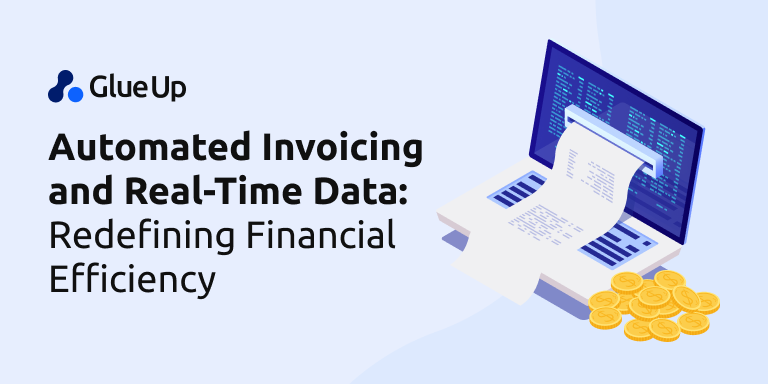![How to Plan a Successful Board Meeting Agenda: A Complete Guide [With a Template] How to Plan a Successful Board Meeting Agenda: A Complete Guide [With a Template]](/sites/default/files/image_1591.png)
Board meetings are important to build trust and encourage open communication that values board members' knowledge and skills to achieve organizational goals. However, running an effective one requires a good combination of preparation and execution.
If you are looking for ways to save time when planning and holding meetings, you've come to the right place. In this article, we'll offer the best ways to develop a good board meeting agenda that can guide you through the items you need to discuss as you generate better ideas and strategies in your organization.
Quick Reads
- What Is a Board Meeting?
- What Are the Items Included in a Board Meeting Agenda?
- Structure of Board Meeting Agenda
- Ways to Take Effective Minutes From Board Meeting Agendas
- Board Meeting Agenda Template
- Best Online Tools for Building a Board Meeting Agenda
What Is a Board Meeting?
A board meeting is a formal meeting of the board of directors in an organization to discuss company policies, significant decisions, and future plans. The board of directors talks about the company's overall business strategy and makes decisions on behalf of stakeholders. During this meeting, key people review performance, offer solutions to major problems, reassess company guidelines, and perform legal responsibilities.
What Are the Items Included in a Board Meeting Agenda?
A board meeting agenda can vary depending on the industry or business, but here's what it usually looks like:
Basic Information
The board agenda header should contain the business name, date, time, location of the board meeting, and contact details.
Call to Order
A call to order is in the first part of the agenda that signals the beginning of a meeting. It is the opportunity for the chairperson to make introductions, mention the company mission and vision, and say that the meeting will now come to order.
Changes to the Agenda
With the chair's approval, members have the freedom to adjust the agenda by amending the points of discussion.
Approval of Previous Minutes
Members can approve or change some of the items from the previous meeting minutes. A secretary is assigned to correct any errors before getting the board’s approval.
Reports

The Executive Director, Head of Finance, and other committee heads should give copies of reports to the board members.
Business Items
There will be a discussion regarding important matters among board members. Action points for committees and individuals can be listed. A voting procedure can occur if necessary.
Announcements
The chair can make special announcements here that mention upcoming projects, new members, congratulations messages, and other people worthy of recognition.
Any Other Business
Board members can further discuss other businesses they would like to raise to the board.
Adjournment
The chair ends the meeting to a close and mentions the date and time of the next one.
Structure of Board Meeting Agenda
A board meeting structure for your agenda is an excellent outline for everyone, especially when noting key decisions. By following a meeting agenda structure, there’s context added to all items that will be valuable in the future. Under each agenda item, make sure to write related information to keep everything organized.
Heading
The heading of the agenda should state the name and address of the organization. It should also include the date, time, and location of the meeting.
Call to Order
It begins with the chair announcing the call to order and time. The secretary is the one to write the time of the call to order in the minutes. After the meeting is called to order, it’s time for the board chair to give welcoming remarks, ask for introductions, or read the organization’s mission and vision statements.
Changes to the Agenda
The second order of business is when the chair asks for any changes needed in the agenda. It’s time to amend the agenda with new items and delete old ones. If there are no changes, the previous meeting minutes can now be approved.
Approval of Minutes
"Approval of Minutes" is the third item on the list that goes with the most recent meeting. Board members should have already received copies of the minutes by this time before the meeting starts. It's an opportunity to raise their concerns or corrections in the minutes. If the secretary isn't informed yet about the changes to the minutes, now is an excellent opportunity.
Reports
Reports fall on the fourth agenda item of board meetings. The Executive Director evaluates the report and gives formal assessment of projects and other initiatives. It should also contain a business outlook overview with current trends, new initiatives, and other essential aspects of a business.
Furthermore, the Head of Finance gives a report after the Executive Director. Board members should analyze and understand timely financial reports to assess business profitability and measure its performance. Understanding financial reports may also provide other stakeholders insight into the company's financial integrity and reliability.
Old Business
Discussing past business items is necessary to get a resolution. You can include items in a table or get committee feedback for further explanation. Initiate a board voting to serve as support if necessary.
In addition, ongoing business activities can also be part of old business. If your company has a pending conference or event, you can now discuss and plan the execution before the date. Employees can update the group regarding their work progress that has been going on in a week or so.
New Business
Managers can plan business with proposals or topics ahead of schedule. They can also communicate prepared items and other new ideas like a revised company policy.
Furthermore, board members should discuss new business items and explain how to execute them. This may mean deciding on a particular date or referring them to a committee head.
Announcements and Other Related Business Activities

Members can now make special announcements like upcoming projects or anniversary messages. Other business suggestions or ideas may also be raised, especially those that need to be decided on in the next meeting.
Adjournment
The board chair officially closes the meeting and mentions the end time. It should now be part of the board meeting minutes that the secretary will prepare. The date of the next meeting should come next, which will serve as a reminder to board members.
Guide to Planning Your Next Board Agenda
It’s essential to plan the agenda before a meeting for board members to know what to prepare before the discussion. Using a template can help you set clear action items for an effective meeting.
A well-structured agenda is crucial for fostering increased engagement among board members. When board members are aware of the meeting's objectives and topics beforehand, they have ample time to prepare, conduct necessary research, and formulate valuable input.
This preparation not only enhances their understanding of the issues but also boosts their confidence and willingness to participate actively in the discussions. A clear agenda prevents unexpected surprises and ensures that everyone is on the same page, leading to more focused and productive conversations.
Moreover, the board of directors can also save time and get organized while working with the resources at hand. With our board meeting agenda template, you can:
Share Agenda in Advance
A well-written meeting agenda should be shared ahead of schedule to allow everyone to prepare and give feedback. Using a board meeting agenda template, you can easily record past meeting minutes, reference documents, and committee reports in an organized structure.
Monitor Action Items
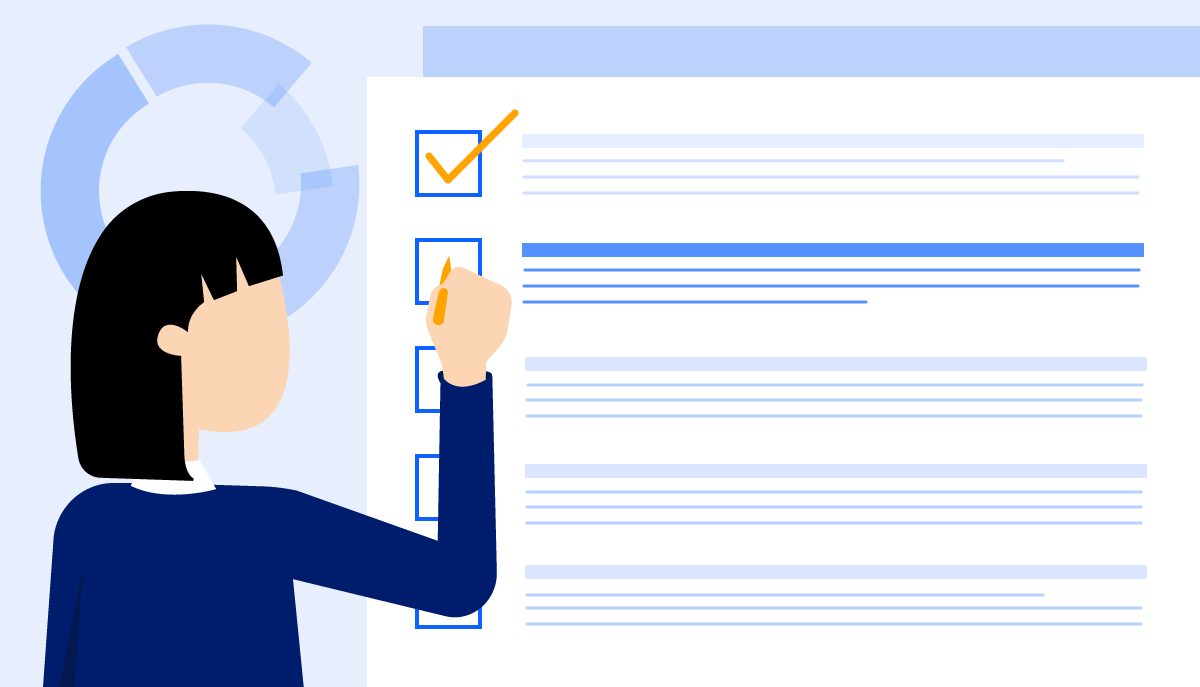
Action items can help meetings stay on track. It’s essential to include them in a list to give every team member a specific duty or responsibility. If you discuss them during the meeting, it will be easier to monitor the progress and check what still needs to be worked on.
Record Important Information
Use a board meeting agenda template to store important information, such as reference docs, past meeting minutes, and committee reports, all in one place.
Stay Committed to Goals
Consider what you want to achieve, commit to it, and create a specific timeframe to accomplish everything. It’s essential to include other priorities that need to be raised during the meeting, like getting new members, performance evaluation, and strategic planning.
Assign Tasks in Advance
Make sure to inform members in advance if topics like project status and updates, budgets, or market research should be discussed. This ensures they have enough data when they present each item in detail, which can save time.
Make Time Allotment
Busy people in an organization have many priorities. Therefore, it’s important to highlight the priority topics. Clearly specify how long each item should run to keep the meeting on track. Doing so can ensure that important items are covered as the discussion progresses.
Work Smarter With Digital Tools
Glue Up’s Corporate Meetings and Events Suite can help you focus on effective collaborative work in your organization. From communication to project management, user-friendly tools like public and private groups and file-sharing space can improve knowledge sharing among members.
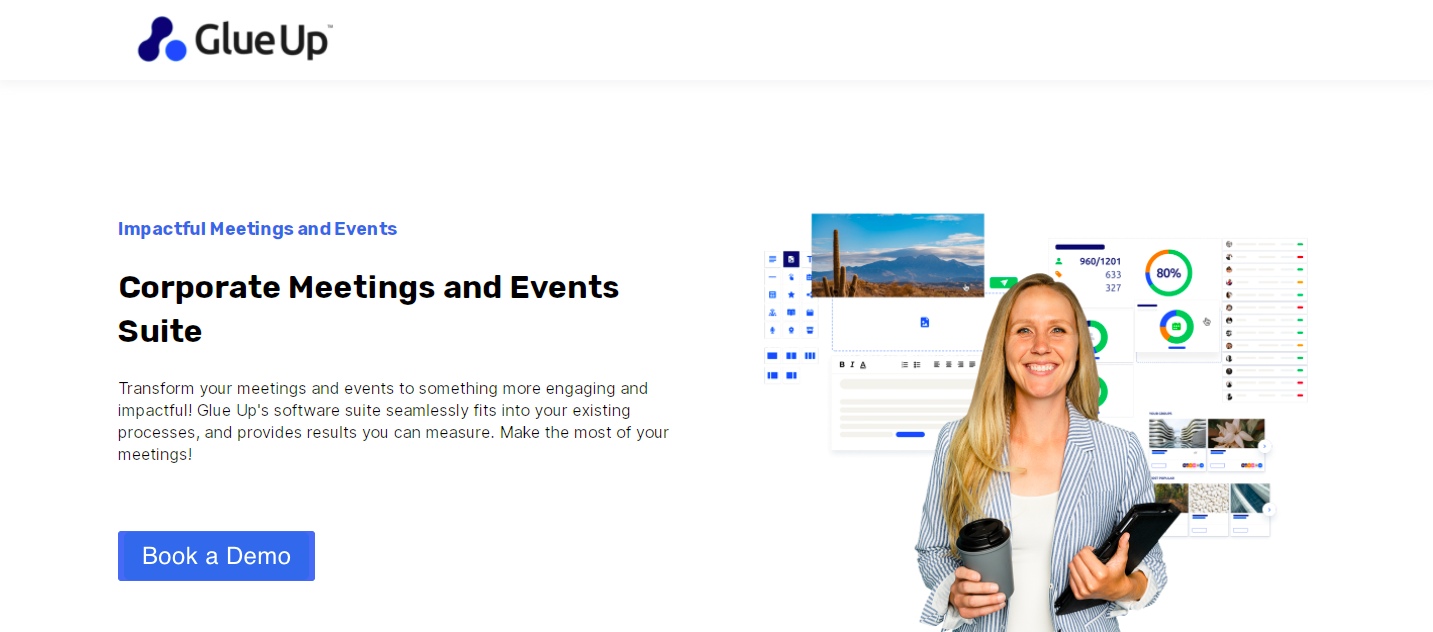
6 Ways to Take Effective Minutes From Board Meeting Agendas
Meeting minutes are references an organization can use for future meetings and clarification of previous discussions. Therefore, you should accurately write board meeting minutes for them to be effective:
1. Create a Sign-in System for Attendance
Prepare a sign-in sheet once you know who to expect in the meeting. A written notice near the entrance can support it: “Welcome to the meeting. Make sure to sign in.”
Another common method for taking attendance includes crossing off names on a board meeting minutes template. Remember to write the names of those who arrive late. It’s crucial to count who's not around for each motion accurately.
2. Bring the Necessary Materials to the Board Meeting
When writing minutes, you can either use a laptop or an old-fashioned pen and paper. Whatever you feel more comfortable with, make sure to prepare the necessities like a notebook, pen, and charger. Consider having a backup method for taking minutes in case you encounter any interruptions.
3. Take Note of the Key People and Their Votes
Everyone needs to know the decisions made and the reasons behind the votes after coming out of the meeting. Minutes shouldn’t record the official votes, and things like motions should be recorded verbatim:
- The exact wording during the motion
- The name of the person who made the motion
- The name of the person who agreed to the motion
- Voting decisions
Remember to focus on the facts and take an objective stance to see things as they really are. Assigning a person who wasn’t present during the meeting to double-check the content is recommended to gain more clarity.
4. Include Important Details
Remember to include all important information raised during a board meeting. Minutes will serve as official legal records included in the board’s legal responsibility.
Other details should be concise, clear, and easy to understand. As a starting point, you can use the following as your guide:
- The meeting venue, date, and time
- The meeting type
- Meeting participants and absentees
- Each motion–who made it, who seconded it, and outcome
- Action items and next steps to perform
- Meeting date and time of the next one
- Adjournment time
The items above can serve as a strong foundation as you develop meeting minutes. Include a short statement regarding an action taken for each agenda, along with the rationale behind every important decision made.
It’s unnecessary to have a complete meeting transcript as too many details can pose some confusion. Therefore, find a middle ground when highlighting the key issues discussed and other plans to lighten the load and maintain balance.
5. Recognize Meeting Protocols for Taking and Approving Minutes
After following the suggestions for writing effective minutes, it’s time to finalize them before distribution. A checklist with protocols can be the following:
Ask for a signature. The chair and secretary should sign the minutes–that’s either a digital or traditional handwritten approach.
Create backup copies. Storing them digitally works best. Best case scenario, use a board portal where you can back the document up on Google Drive, Dropbox, or OneDrive.
Send the minutes to board members quickly. Refer to the guest list and all individuals should receive a copy, regardless of whether they attended or not. The best time to send out the minutes is within 48 hours after the meeting.
6. Distribute Meeting Minutes With the Right Tools
You can distribute finalized board meeting minutes via email or hard copy. It’s best to use Glue Up’s Community Management software to store your organization’s information securely. You can perform media and location sharing in the platform, which allows all members to have equal control and opportunities to access files and contribute to conversations in real time.
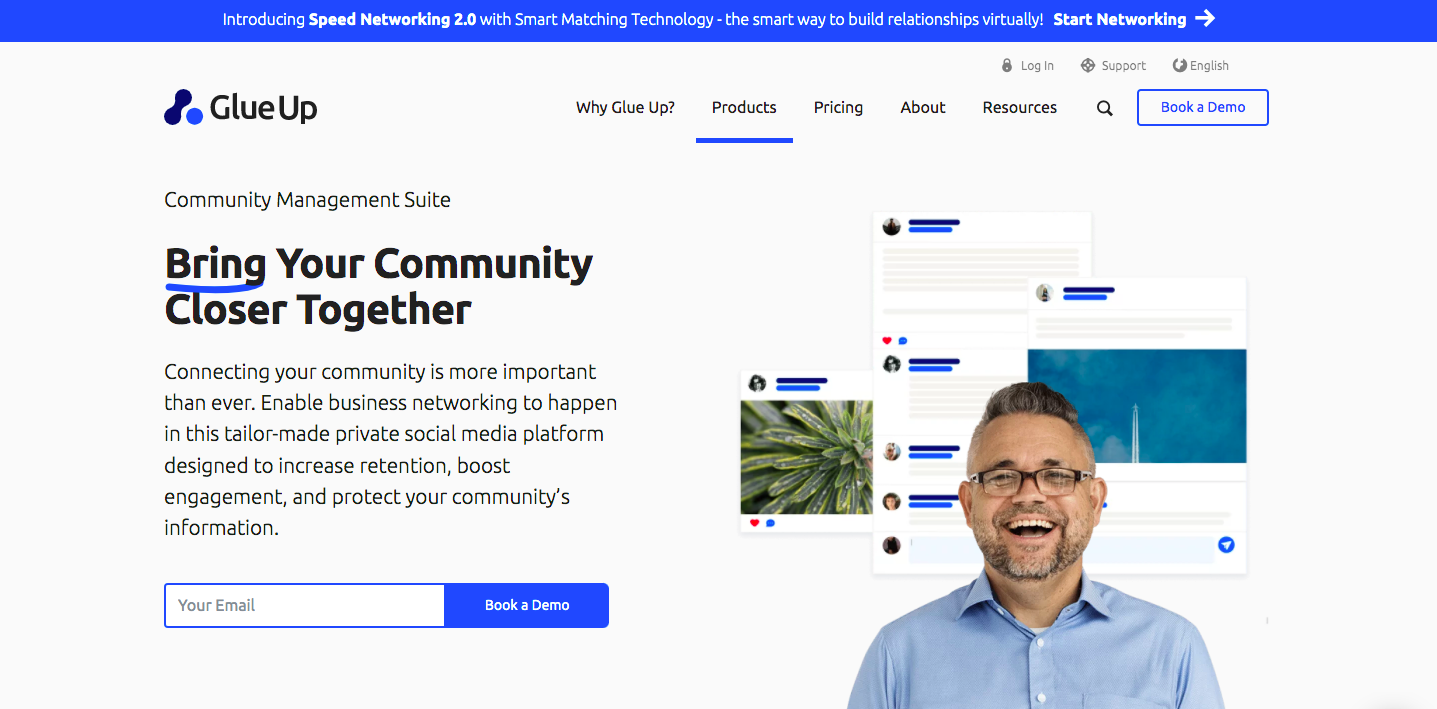
Board Meeting Agenda Template
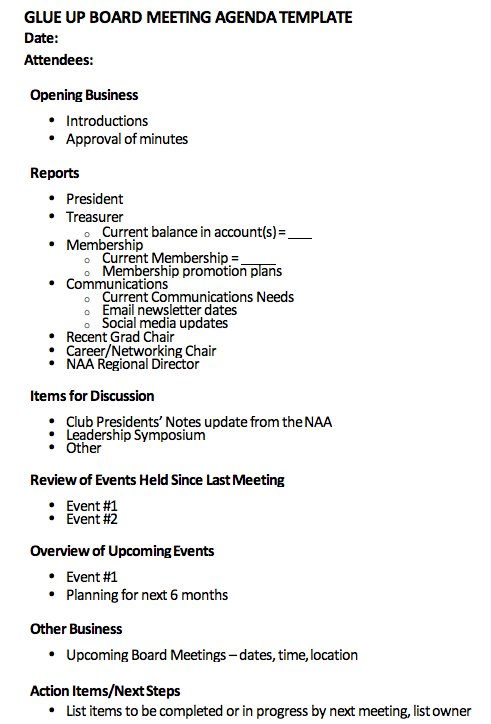
Best Online Tools for Building a Board Meeting Agenda
Easily design an agenda for your next board meeting with these top digital tools:
1. OnBoard
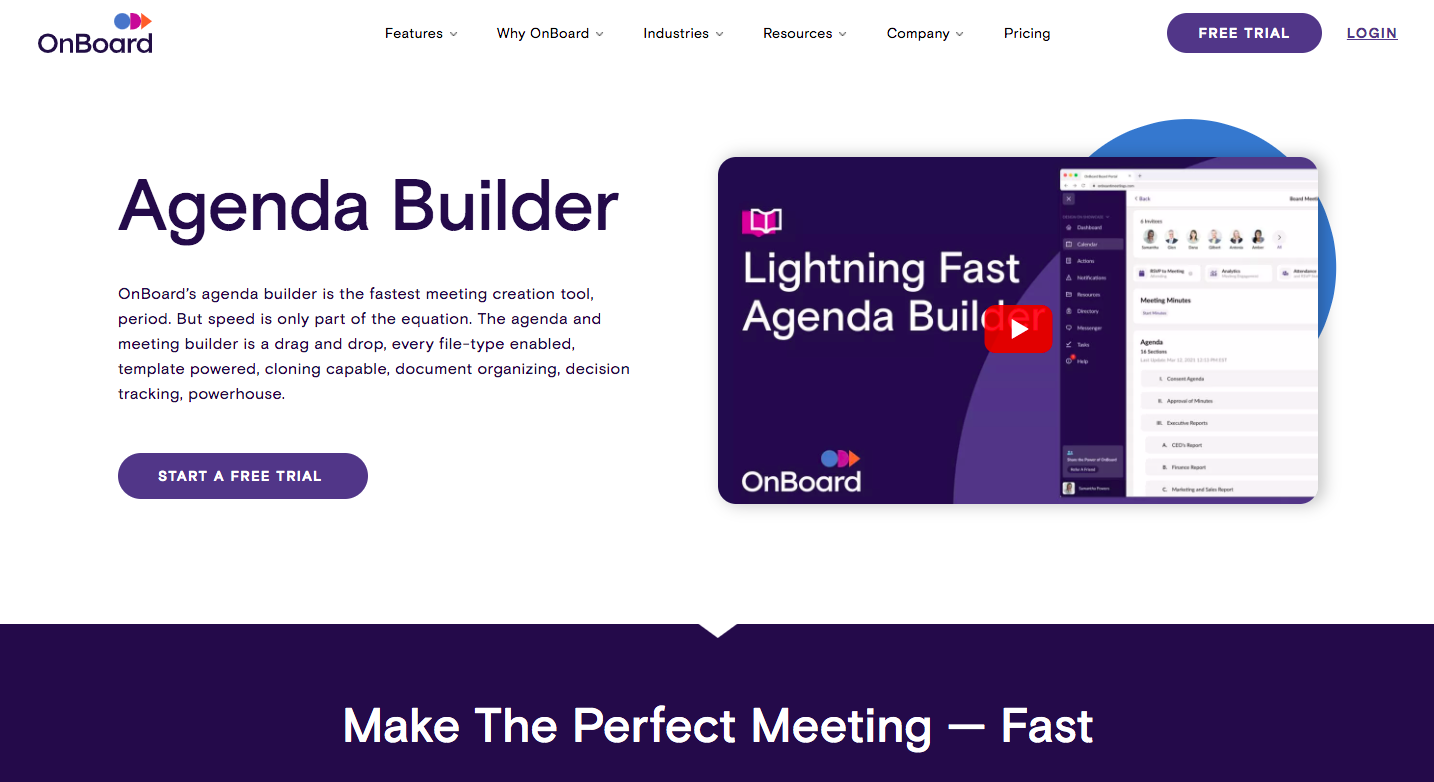
OnBoard is a drag-and-drop agenda builder with powerful tools you can use to create an effective agenda. With its Agenda Time Management, you can keep the meeting focused and on schedule as you evaluate information, assess alternatives, and make a final decision.
2. BoardPro
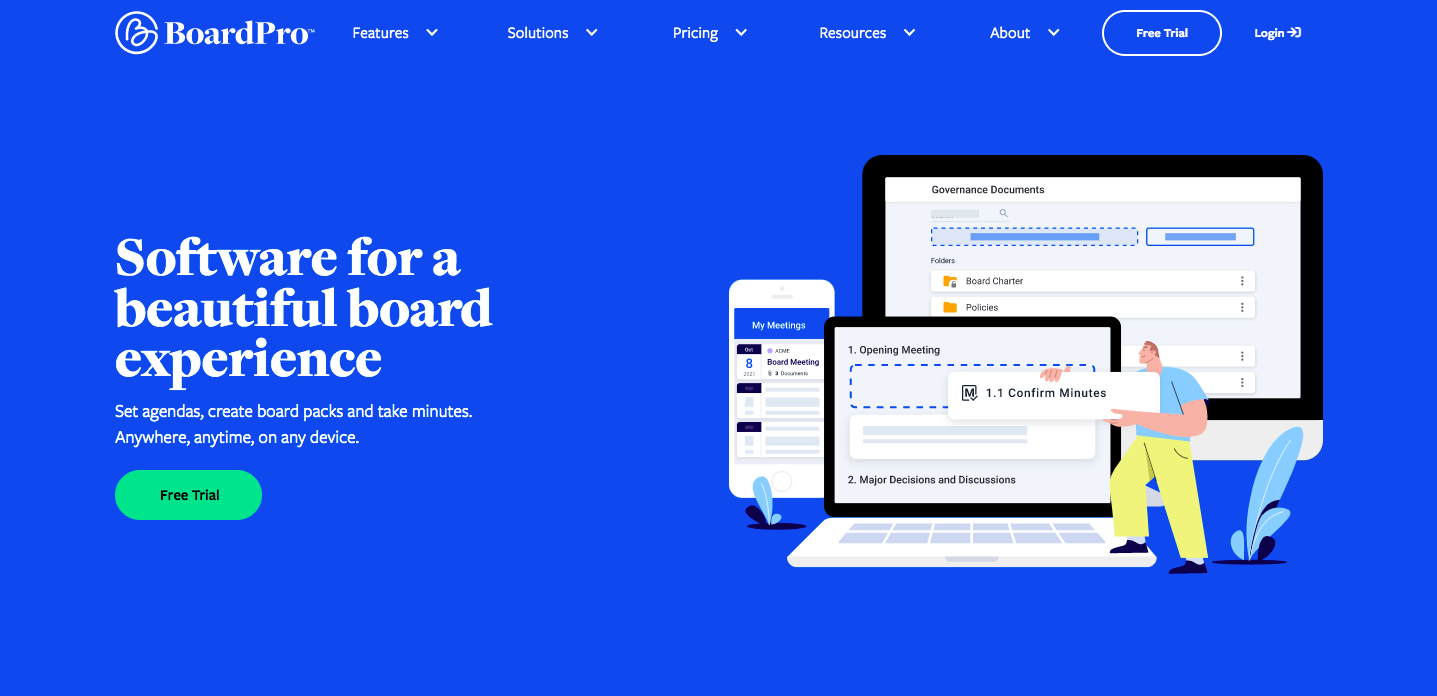
BoardPro is a meeting agenda builder that helps quickly create, organize, and share the meeting agenda to everyone before fully engaging in a meeting. Its 'smart agenda items' can enable automated meetings by confirming past discussions' minutes and reviewing action items that are part of them.
3. Boardable
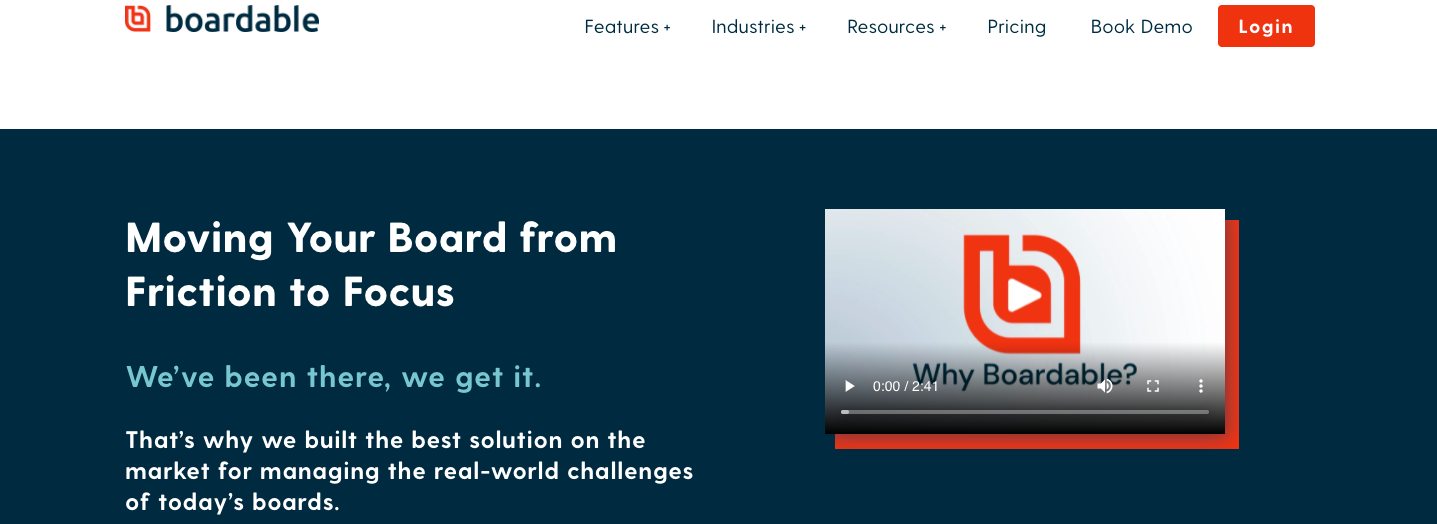
Boardable is another board management tool for meetings that offers a centralized board portal for collaboration and fully integrated video conferencing that can empower members to be more productive, connected, and engaged.


